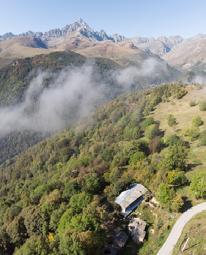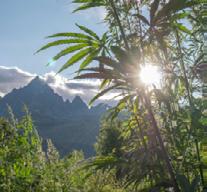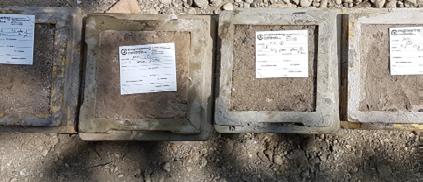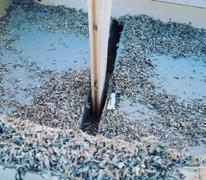
10 minute read
Hemp as Incubator of a circular Economy
Tobias Luthe | MonViso Institute
Exploring hemp systems at the Moviso Institute, a real-world mountain laboratory for systemic regenerative design
Hemp is a circular plant with all its parts potentially having societal, ecological or industrial value, direct or indirect. This systemic value can be harnessed to help incubate a more circular, bio-based economy, a transition from our current linear, crude-oil based economy, being of critical importance to create regenerative, resilient societies and thereby address current pressing environmental and social problems. Finding and implementing solutions to such complex problems requires systemic design techniques and methodologies, building upon science, technology, creativity, and participation. Sounds complex? It surely is. In order to thrive for this systemic change to happen, we need to increase and accelerate our efforts to develop common visions, contextual understanding and motivational experiences, building knowledge and spurring cooperation. Basically, to simplify the complex and make it accessible, desirable, tangible, applicable. The MonViso Institute in the Italian Piedmont is being designed as an experimental lab where people can experience such complexity in real life. One such example is the revival of hemp as a forgotten plant, and its potential contribution to incubate a more sustainable, circular bio-economy. History and potential of hemp need to translate into timely systemic solutions, which is one of the activities of the MonViso Institute (Luthe et al.a). Some remote, abandoned or neglected mountain regions already experience a recently developing migration from cities back to the mountains, referred to as “Alpine urbanism”.

The MonViso Institute is located in Valle Po, Piedmont, Italy An experiential systemic design center with alpine-urban hemp circularity as one focus
Alpine urbanism leads to a local influx of human activity and innovation but demands regional employment opportunities. Fundamental for reviving mountain communities is the development of a resilient economic model that allows for local economic revenue, enabling circular flows of resources, services and people. The reasoning behind heavily subsidized dairy mountain farms, for example, needs to be questioned and alternative, more sustainable land use needs to be elaborated. Traditionally used industrial hemp is such an alternative, re-gaining importance as a resource for food (protein-rich oils and flour), for fiber (clothing, composite materials in engineering), bio-based plastics and synthetics, construction material (insulation, bricks, panels), medicinal use and cosmetics, and for tourism. Such resources and usages create connective flows between agricultural growth, landscape use, the tourism economy and livelihoods in mountain regions; and processing, production and consumption markets in and near urban areas, leading to economic, ecological and social potential (Figure 1).
Hemp as a circular plant in a circular economy
What do we mean by “circularity”? Nature functions circular. In nature, no waste exists. Only humans leave waste, outputs that no one can use and that even are destructive if amounts exceed planetary boundaries – like, for example, carbon dioxide, a major greenhouse gas. We need to re-design our economies in a circular way where atmospheric carbon is reduced, stored and then recycled – as plants do. One pathway of circularity is the potential of hemp for substituting various carbon-intensive, linear industrial processes and products. Being a fast-growing plant, hemp sequesters high amounts of carbon dioxide from the atmosphere, compared to a natural forest. On average, the carbon sequestration of hemp is about 0.67t CO2/hectare/year (Pervaiz and Sain 2003). If this biomass is used in a way that is turned into consistent material, it stores carbon for its lifetime. If it substitutes more carbon-intensive materials and products, it may as well have a net-positive carbon budget. Carbon-intensive industrial processes and products are, in especial, the building sector, the composite industry, and electric and thermal energy production. Of further systemic interests are the food sector, the health sector, textiles, and tourism. The needed economic, social and overall systemic innovation accelerate growth in the demand for industrial hemp use in urban markets, resulting in increased market prices for hemp. This stimulates its agricultural use especially in areas of lower fertility or “extreme” steepness, regularly found in upper mountainous valleys (Figure 1). Federal agricultural subsidies can be partly re-directed from the current focus on dairy, sweet corn and wheat for stimulating higher connectivity in between economic sectors for enhanced circularity - in hemp and other sectors (e.g. tourism, education, construction and agro-forestry) and increased local employment. The ecological consequences are local soil improvements, improved water regimes, and increased carbon sequestration towards the carbon reduction goals of a country (Figure 1).
Experiences with hemp systems at the Monviso Institute
At the MVI, we explore some of hemp’s circular potential and make it accessible for education and capacity building. In 2017, MVI co-founder Melanie Rottmann introduced industrial hemp to the MVI campus on 1500m elevation asl. Since then, we have experienced three seasons of hemp growth and usage.
Growing hemp in the mountains ist not a trivial task
Our small hemp field of about 1500m2 size is situated on 1500m asl on a Southern exposed slope. The soil quality is rich in nitrogen due to decades of cow grazing manure in summer, but the topsoil A-horizon layer is quite thin with about 15cm thickness. Annual precipitation is about 700-1000mm, the average annual temperature is about +7°C. In the first year, we had to use a tractor rotary hoe to open the thick grass layer and to be able to sow the hemp. It grew quite fast up to heights of 3m, though not really in a part of the field where we unconsciously took away the topsoil layer for landscaping another location of the MVI campus. In this part, even in the third year of working to rebuild the topsoil humus layer, hemp grows very sparsely or not at all. We were astonished about the difficulty hemp has on this poor soil to grow, testing two types of hemp with no differences on the growth success on this soil part (Carmagnola and Fedora). In the 2nd and 3rd year, we experienced repetitive extreme hail events just after sowing time (end of May-begin of June), and again in July, which harmed a large percentage of the young seedlings. It has been proven not easy to grow hemp up here in this climate and soil conditions, under increasingly strong extreme events with a warming climate, i.e. hail storms in summer.
Fibers – Innovation potential in composite materials
From our successful first growth season, we used the hand-extracted fibers to produce circular skis. Based on experiences in ecological ski design with the “Grown outdoor creativity lab”, and as part of a systemic design lab teaching course with master students in engineering at ETH Zurich, we built freeride skis made from Paulownia wood - hemp composite, laminated with partly bio-based epoxy resin. We as well test Paulownia tree growth (“aluminum of wood”) in alpine conditions next to our hemp field. These skis won two design prices at ISPO 2018 in Munich. Based on life cycle assessment, these highly performant skis have a reduced environmental footprint by about 50% (Luthe et al.b). They are a successful systemic innovation and prove the potential of hemp for lightweight, high-tech and carbon-neutral to positive composites, substituting non-renewable materials.

hemp field
Shives and fibers – Building and insulating with hemp
The first house we rebuilt on the MVI campus is a duplex apartment building. It is a wooden passive net-positive house, producing 200% of the used electricity, packed with circular design solutions. We tested hemp fibers and shives as reinforcement in the concrete foundation slab, substituting steel with renewable resources that would even store carbon, using Roman/Grenoble cement instead of conventional Portland cement for a 40% lower carbon footprint. The fibers were almost impossible to mix with the cement without bulking, despite of using about 10- 30mm short fibers. The shives mixed well, but the concrete collapsed at these softer pockets under compression.

Grown hemp skis
Flexibility was increased, compression decreased. We thus slightly increased the thickness and came up with a pure Grenoble cement-sand-water slab, without reinforcement the lowest embodied energy a concrete slab can have. Its environmental footprint could still be improved by replacing some virgin material with recycled concrete.
We poured shives in the space in between the wood walls of the two duplex halves as extra thermal and sound insulation. The wooden floors are insulated with shives and the remaining fibers which we could not use in the slab. Hemp fleece stripes are used as sound decoupling layer between the supporting floor rafters and the hardwood floors on both house levels. The space between the wooden window frames and the wooden walls is stuffed with hemp fibers.
As one of the next buildings to rebuild, the “taverna” will demonstrate solemnly hemp building systems, such as the hemp brick from pioneering inventor Werner Schönthaler.
We built a wood oven to make Pizza and bread, insulated with multiple layers of in total 20cm hempcrete, a mix of Grenoble cement and hemp shives.

renoble cement with hemp shives reinforcement compression tests

Blossoms, leaves and seeds - hemp as food
We offer hemp seeds as protein snacks and brew tea with dried leaves and blossoms. From part of the blossom harvest, we extract the CBD. We also mix hemp flour from the seeds and chestnut flour to make pizza and bake

Pizza oven in construction and group use bread in the wood oven.
Facilitating shared learning and experiences
The MVI hemp field is an important communication tool. In the growth season, hikers and cars stop to read the large explanation sign at the fence of the campus, explaining the legal and circular aspects of industrial hemp in English and Italian, laser engraved into appealing chestnut wood. Local older people contact us full of happiness, since they remember hemp being part of their childhood here in the mountains, since Ostana and the Piedmont have a rich history of hemp growth and use. The Ostana museum explains the historical use of hemp, and a new tourism path “Open Book” connects the museum with our QR tagged hemp field. The hemp field was setup as a hemp labyrinth with a sitting area in the middle, ideal for visitors and course participants to dive into the fascination of hemp. We are hoping for a better growth season though to fully engage this offer, including a small hemp products pop-up store.

Outdoor Futures hemp sowing

Workshops and hemp sowing
For current and future MVI course offers in permaculture, systemic engineering and design, ski building, circularity and others, the hemp field and the many applications on the campus are of high educational value to teach and understand circularity. For example, “Outdoor Futures”, a new Think and Do Tank for Sustainability by the European Outdoor Group (EOG), had their gathering at the MVI and engaged in a hemp sowing afternoon – for social value, local contribution, and partly offsetting their carbon travel emissions. The next and 4th edition of the Monviso Regenerative Design Talks is about hemp building systems.
Ongoing and proposed research avenuess
Hemp is a plant that is well equipped to demonstrate circularity and to incubate a circular economy. The plants’ multiple usages have been described in the literature, and the current momentum brings up new science insights, illustrations and marketable products, while many challenges remain. For example, in order to spur and upscale circular hemp systems, a scalable supply of quality-controlled hemp fiber for the fabric and clothing sectors is lacking, and with this the right machinery. The composite industry still largely concentrates on glass and carbon fibers, with some developments in flax composites – both flax and hemp have a promising potential to substitute glass and in parts carbon. Mountain agriculture in the Alps is largely dependent on subsidies for dairy livestock, leading to higher methane emissions, nitrogen built-up and erosion from trampling. Hemp could be a systemic innovation here as well, making “extreme” mountain slopes worthwhile to grow hemp on, while re-directing public subsidies to foster regional supply chains. Yet we lack data on the overall scalable growth, its market potential and on circularity effects between urban markets, alpine revenues and spatial development. As an example, there is a lack of spatial modeling data for hemp as a major land use crop; we do not know enough about local and tourism acceptances of hemp in the landscape. The systemic relational value of a hemp-driven circular bio-economy is not modeled and quantified yet, neither on local, regional and global scales, nor between the alpine as traditional growth areas and the urban as new high-tech markets (Figure 1). Further research entails to develop concrete resource- and financial footprints for development scenarios, and policy recommendations for the transition from traditional use, legal abandonment, and future potential for incubating a more connected, circular bio-economy based on hemp. The innovation potential of such research leads to the improvement of economic and social wellbeing, specifically in often neglected peripheral mountain communities and valleys, to ecologically improved landscape management, and to the overall reduction of the carbon footprint of entire economies.










